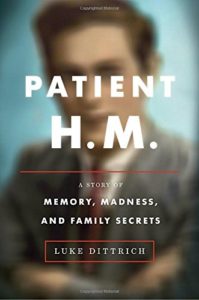If Henrietta Lacks gave the world an unending supply of Human Cells to experiment and create vaccines, Patient H. M. has the dubious distinction of being the most researched and probed brain. Neuroscience has improved by leaps and bounds in the last few decades. But most of what we know about human brain and its physiology is by looking at what is missing, than what is present.
Patient H. M. or Henry Gustav Molaison was walking back form a nearby park one evening when he was knocked down by a bicycle rider. His head struck on the pavement and jarred the tightly packed brain tissue with such force that it never returned to its original state. As time progressed, the injury got worst and the day came when Molaison was no longer able to form new memories.
Luke Dittrich is a National Magazine Award–winning journalist, and a contributing editor at Esquire.
 Patient H.M.: A Story of Memory, Madness, and Family Secrets
Patient H.M.: A Story of Memory, Madness, and Family Secrets
Author: Luke Dittrich
Hardcover: 464 pages
Publisher: Random House; 1 edition (August 9, 2016)
ISBN: 0812992733, 978-0812992731
Henry Molaison was not the only such case. What makes him special is that he was probed and prodded across various premiere institutions in the U.S. for years. As much as it the story Henry Molaison, Patient H. M. is also an informal history of Neurosurgery and the premise of connecting brain physiology to many mental illnesses.
The author chronicles the events in Molaison’s life in parallel with developments in neurosurgery research and the rush to find concrete solution to hitherto unknown mental illnesses. He gives a glimpse behind how the first mental asylums came into existence in the U.S. and how once again, government policies and investments made it possible doctors to spend time on research.
The book is by no means for someone who does not like graphic visuals. The author discusses various surgical experiments that surgeons across US and Europe went through, like trying to access the frontal lobes from different locations and different primitive devices until they gave the world Lobotomy, that is, removal of lobe tissue.
He explains how these surgical experiments unravels that brain is not a single unified entity but has specific areas dedicated to specific functions like Wernicke’s area or Broca’s area for speech.
Patient H. M. is an interesting read for most medical students and those associated with medicine. It is also a great read for people who are fascinated by how human brain works and typically love to watch medical drama on television. Although Luke Dittrich doesn’t make the narrative as interesting as Rebeca Skloot, if you stick around, there is lot that is worth reading there.